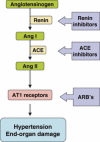Renin-angiotensin system revisited
- PMID: 18793332
- PMCID: PMC7166930
- DOI: 10.1111/j.1365-2796.2008.01981.x
Renin-angiotensin system revisited
Abstract
New components and functions of the renin-angiotensin system (RAS) are still being unravelled. The classical RAS as it looked in the middle 1970s consisted of circulating renin, acting on angiotensinogen to produce angiotensin I, which in turn was converted into angiotensin II (Ang II) by angiotensin-converting enzyme (ACE). Ang II, still considered the main effector of RAS was believed to act only as a circulating hormone via angiotensin receptors, AT1 and AT2. Since then, an expanded view of RAS has gradually emerged. Local tissue RAS systems have been identified in most organs. Recently, evidence for an intracellular RAS has been reported. The new expanded view of RAS therefore covers both endocrine, paracrine and intracrine functions. Other peptides of RAS have been shown to have biological actions; angiotensin 2-8 heptapeptide (Ang III) has actions similar to those of Ang II. Further, the angiotensin 3-8 hexapeptide (Ang IV) exerts its actions via insulin-regulated amino peptidase receptors. Finally, angiotensin 1-7 (Ang 1-7) acts via mas receptors. The discovery of another ACE2 was an important complement to this picture. The recent discovery of renin receptors has made our view of RAS unexpectedly complex and multilayered. The importance of RAS in cardiovascular disease has been demonstrated by the clinical benefits of ACE inhibitors and AT1 receptor blockers. Great expectations are now generated by the introduction of renin inhibitors. Indeed, RAS regulates much more and diverse physiological functions than previously believed.
Conflict of interest statement
No conflict of interest was declared.
Figures

 ) indicate pathways; the clinical significance of which has been demonstrated. Dashed arrow (
) indicate pathways; the clinical significance of which has been demonstrated. Dashed arrow ( ) indicates pathway deduced from animal or cell culture experiments, not yet conclusively shown to be clinically relevant.
) indicates pathway deduced from animal or cell culture experiments, not yet conclusively shown to be clinically relevant.


 ). Activated renin then generates Ang I from angiotensinogen (AGT) and angiotensin‐convering enzyme generates Ang II from Ang I, and Ang II can then activate AT1 receptors on the same cell membrane. Signalling via extracellular signal‐regulated kinase (ERK) 1/2 leads to activation of genes. Modified from Nguyen 2007 [52].
). Activated renin then generates Ang I from angiotensinogen (AGT) and angiotensin‐convering enzyme generates Ang II from Ang I, and Ang II can then activate AT1 receptors on the same cell membrane. Signalling via extracellular signal‐regulated kinase (ERK) 1/2 leads to activation of genes. Modified from Nguyen 2007 [52].
Comment in
-
Angiotensin, the hypovolaemia hormone, aggravates hypertension, obesity, diabetes and cancer.J Intern Med. 2009 May;265(5):616-7. doi: 10.1111/j.1365-2796.2008.02037.x. Epub 2008 Nov 19. J Intern Med. 2009. PMID: 19019186 No abstract available.
-
IRAP and AT(1) receptor mediated effects of angiotensin IV.J Intern Med. 2009 Mar;265(3):401-3; author reply 404-5. doi: 10.1111/j.1365-2796.2008.02027.x. J Intern Med. 2009. PMID: 19207373 No abstract available.
References
-
- Tigerstedt R, Bergman P. Niere und Kreislauf. Scand Arch Physiol (Germany) 1898; 8: 223–71.
-
- Ondetti MA, Rubin B, Cushman DW. Design of specific inhibitors of angiotensin‐converting enzyme: new class of orally active antihypertensive agents. Science 1977; 196: 441–4. - PubMed
-
- Timmermans PB, Wong PC, Chiu AT et al. Angiotensin II receptors and angiotensin II receptor antagonists. Pharmacol Rev 1993; 45: 205–51. - PubMed
-
- Kumar R, Singh VP, Baker KM. The intracellular renin‐angiotensin system: a new paradigm. Trends Endocrinol Metab 2007; 18: 208–14. - PubMed
-
- Ran J, Hirano T, Fukui T et al. Angiotensin II infusion decreases plasma adiponectin level via its type 1 receptor in rats: an implication for hypertension‐related insulin resistance. Metabolism 2006; 55: 478–88. - PubMed
Publication types
MeSH terms
Substances
LinkOut - more resources
Full Text Sources
Other Literature Sources
Molecular Biology Databases
Research Materials
Miscellaneous

